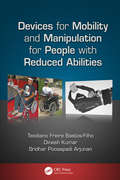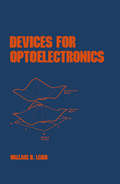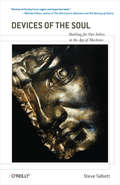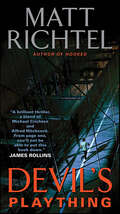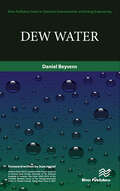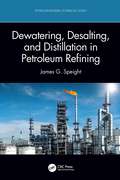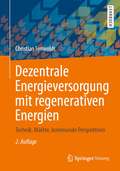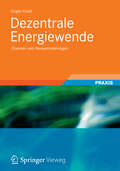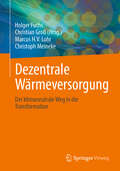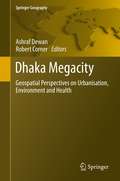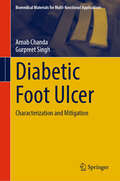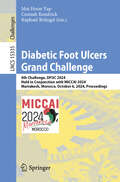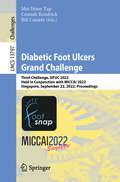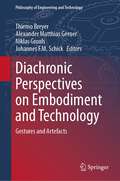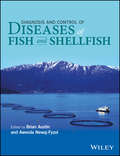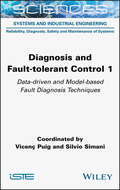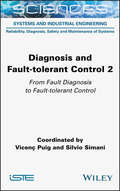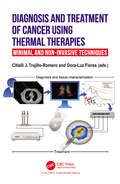- Table View
- List View
Devices for Mobility and Manipulation for People with Reduced Abilities (Rehabilitation Science in Practice Series)
by Dinesh Kumar Sridhar Poosapadi Arjunan Teodiano Bastos-FilhoThe development and application of assistive technology can help those with reduced abilities improve their quality of life and reduce their dependence on others. Written in layman's terms, Devices for Mobility and Manipulation for People with Reduced Abilities provides research and information on assistive technologies for non-technical people. Wh
Devices for Optoelectronics (Optical Science And Engineering Ser.)
by Wallace B. LeighOffers coverage of optical devices utilized in communication and information processing systems, highlighting the physics of optoelectronics necessary for both hybrid and monolithic optical integrated circuits. The text aims to bridge the gap between thin-film switches and active semiconductors by analyzing lithium niobate as well as compound semiconductor devices, and includes discussion on optical transmitters, receivers and switches.
Devices of the Soul: Battling for Our Selves in an Age of Machines
by Steve Talbott"Self-forgetfulness is the reigning temptation of the technological era. This is why we so readily give our assent to the absurd proposition that a computer can add two plus two, despite the obvious fact that it can do nothing of the sort--not if we have in mind anything remotely resembling what we do when we add numbers. In the computer's case, the mechanics of addition involve no motivation, no consciousness of the task, no mobilization of the will, no metabolic activity, no imagination. And its performance brings neither the satisfaction of accomplishment nor the strengthening of practical skills and cognitive capacities."In this insightful book, author Steve Talbott, software programmer and technical writer turned researcher and editor for The Nature Institute, challenges us to step back and take an objective look at the technology driving our lives. At a time when 65 percent of American consumers spend more time with their PCs than they do with their significant others, according to a recent study, Talbott illustrates that we're forgetting one important thing--our Selves, the human spirit from which technology stems.Whether we're surrendering intimate details to yet another database, eschewing our physical communities for online social networks, or calculating our net worth, we freely give our power over to technology until, he says, "we arrive at a computer's-eye view of the entire world of industry, commerce, and society at large...an ever more closely woven web of programmed logic."Digital technology certainly makes us more efficient. But when efficiency is the only goal, we have no way to know whether we're going in the right or wrong direction. Businesses replace guiding vision with a spreadsheet's bottom line. Schoolteachers are replaced by the computer's dataflow. Indigenous peoples give up traditional skills for the dazzle and ease of new gadgets. Even the Pentagon's zeal to replace "boots on the ground" with technology has led to the mess in Iraq. And on it goes.The ultimate danger is that, in our willingness to adapt ourselves to technology, "we will descend to the level of the computational devices we have engineered--not merely imagining ever new and more sophisticated automatons, but reducing ourselves to automatons."To transform our situation, we need to see it in a new and unaccustomed light, and that's what Talbott provides by examining the deceiving virtues of technology--how we're killing education, socializing our machines, and mechanizing our society.Once you take this eye-opening journey, you will think more clearly about how you consume technology and how you allow it to consume you."Nothing is as rare or sorely needed in our tech-enchanted culture right now as intelligent criticism of technology, and Steve Talbott is exactly the critic we've been waiting for: trenchant, sophisticated, and completely original. Devices of the Soul is an urgent and important book."--Michael Pollan, author of The Omnivore's Dilemma: A Natural History of Four Meals and The Botany of Desire: A Plant's Eye View of the World"Steve Talbott is a rare voice of clarity, humanity, and passion in a world enthralled by machines and calculation. His new book, Devices of the Soul, lays out a frightening and at the same time inspiring analysis of what computers and computer-like thinking are doing to us, our children, and the future of our planet. Talbott is no Luddite. He fully understands and appreciates the stunning power of technology for both good and evil. His cool and precise skewering of the fuzzy thinking and mindless enthusiasm of the technology true believers is tempered by his modesty, the elegance of his writing, and his abiding love for the world of nature and our capacity for communion with it. "--Edward Miller, Former editor, Harvard Education Letter"Those who care about the healthy and wholesome lives of children can gain much from Steve Talbott's wisdom. He examines the need to help children spe
Devil's Plaything
by Matt Richtel“Smart, captivating, sophisticated; I can’t say enough about this deftly told story.”—Steve Berry, New York Times bestselling author of The Emperor’s Tomb“A brilliant thriller that defies genre and scope; a twisted blend of Michael Crichton and Alfred Hitchcock.”—James Rollins, New York Times bestselling author of Altar of EdenA Pulitzer Prize winner for Journalism in 2010, New York Times science reporter Matt Richtel delivers a phenomenal “neuro-tech” thriller about a dark and insidious plot to reengineer the human brain. Devil’s Plaything is smart, fast, and terrifyingly plausible—a page-turner of the first order from the critically acclaimed author of Hooked, whom author David Liss (The Devil’s Company) calls, “The absolute master of crafting amazing fiction around cutting edge science.”
Devising a Clean Energy Strategy for Asian Cities
by Hooman FarzanehThis book capitalizes on two hot topics: the Low Carbon Emission Development Strategies and climate change in Asian cities. There is resurgence in making policies to investigate more aspects of the energy-environment spectrum for the global energy market in the future. This book helps the policy makers and researchers to understand which actions should be taken to reduce the environmental impacts of economic activities in different regions in Asia. The clean energy strategy proposed in this book refers to the development and implementation of policies and strategies that simultaneously contribute to addressing climate change and solving local environmental problems, which also have other development impacts. It provides insights to a wide audience on successful ways to promote, design and implement the clean energy policies in Asian cities. To determine the global actions, it is necessary to make breakthroughs by promoting further research and to present scenarios that achieve Low Emission Development Strategies (LEDS) goals without dependence upon fossil fuels. The scenarios and case studies discussed in this book are helpful to plan for the SDGs, where various objectives have to be achieved at the same time. The UN 2030 development agenda needs innovative planning to achieve multiple goals with limited resources and generate synergy among sectors. This book will be one of the first books available on this subject.
Dew Computing: The Sustainable IoT Perspectives (Internet of Things)
by Debashis De Samarjit RoyThis book discusses the dew computing paradigm with the evolution of future-generation technologies through the cloud and the Internet of Things in the scope of machine intelligence. Dew computing is an emerging paradigm that inherits a flexible and super-hybrid methodology to afford personal information to users with self-regulating internetwork connectivity. The contents conceptualize how the end-users can benefit from data analytics through intelligent data sensing, computing, analytics, and distributed scenarios using a dew-cloud computational framework over the Internet of Things environment. The main focus of this book is to bring all the related technologies into a single platform so that undergraduate and postgraduate students, researchers, academicians, and the industry can easily understand dew computing, future generations of cloud computing, machine intelligence, and representation learning in IoT-enabled technologies.
Dew Water
by Daniel BeysensThe world’s ever-increasing need for fresh water has led to the use of non-conventional sources such as rain and fog water collection. Although rain water collection is relatively simple, the supply is often erratic. Passive fog water collection has been used in several parts of the world but is only relevant to certain geographical locations. Dew occurrence, however, is far more widespread, can form in most climates and geographic settings, show high frequency and prevalence throughout the year. During the past 20 years, dew collection has therefore been investigated as a serious supplemental source of fresh water. Dew Water offers a thorough review of dew, its formation characteristics and potential for dew collection, for audiences that include policy-makers, non-governmental organizations involved in development aid and sustainable development, engineers, urban planners, researchers and students.After providing a background on atmospheric water, humid air, and sky and materials emissivity, the book deals with dew formation and its estimation with a focus on the use of meteorological data. Dew measurement techniques are reviewed and discussed as well as dew collection by passive means. Computational fluid dynamics technique is described for better design of dew collectors. Dew quality (chemistry, biology) is assessed in view of potable water quality. Costs and economic aspects are also considered.
Dewatering, Desalting, and Distillation in Petroleum Refining (Petroleum Refining Technology Series)
by James G. SpeightThis book presents a detailed and practical description of various processes – dewatering, desalting, and distillation – that prepare refinery feedstocks for different conversion processes they will go through. Relevant process data are provided, and process operations are fully described. This accessible guide is written for managers, professionals, and technicians as well as graduate students transitioning into the refining industry. Key Features: • Describes feedstock evaluation and the effects of elemental, chemical, and fractional composition. • Details the equipment and components and possible impacts due to composition. • Explores the process options and parameters involved in dewatering, desalting, and distillation. • Considers next-generation processes and developments.
Dezentrale Energieversorgung mit regenerativen Energien: Technik, Märkte, kommunale Perspektiven
by Christian SynwoldtDas vorliegende Buch bietet eine Übersicht und Einführung in die Verfahren regenerativer Energiegewinnung sowie deren technische Grundlagen. Es ist als Lehrbuch konzipiert und kann auch als Handbuch und Nachschlagewerk eingesetzt werden. Ferner sind Verfahren berücksichtigt, die in Europa nicht gängig sind, wie z. B. Aufwindkraftwerk oder Solarteich. Damit ist es für internationale Projekte und im Umfeld technischer Zusammenarbeit einsetzbar. Neben der intensiven Auseinandersetzung mit technologischen Aspekten steht die systemische Betrachtung der Energieversorgung im Mittelpunkt. Außerdem sind Konzepte zur Entwicklung des ländlichen Raums sowie Finanzierungs- und Marktmodelle besprochen.Durch zahlreiche Backgroundinformationen („Abflussgrößen in der Hydrologie“ oder „Weltweiter Kostenvergleich von Photovoltaikanlagen“) kann das Grundlagenwissen eigenständig erweitert werden und das Buch je nach Studienphase zur Intensivierung und Wiederholung der Lerninhalte immer wieder herangezogen werden. Berechnungen sind an konkreten Fragestellungen durchgeführt. Auf diese Weise regt der Autor an, das angeeignete Wissen zur kritischen Einschätzung von Sachverhalten zu verwenden.
Dezentrale Energiewende
by Jürgen EiseltDieses Buch ist eine umfassende Bestandsaufnahme für eine bereits angelaufene dezentrale Energiewende. Es wird anhand vorhandener Strukturen, Techniken und wissenschaftlich fundierten Erkenntnissen die Potentiale einer wirkungsvollen Energiewende beschrieben. Ziel dieses Buches ist Darstellung neuer Techniken und efferktiver Konzepte, damit dezentrale Strukturen die zentrale Energieversorgung ablösen. Hauptantrieb für den Einsatz der dezentralen Energieformen sind Kostenreduzierung, energieautarke Systeme bis zur Null-Tarif-Heizung.
Dezentrale Wärmeversorgung: Der klimaneutrale Weg in die Transformation
by Christian Groß Holger Fuchs Marcus H.V. Lohr Christoph MeinekeEnergieversorger, Planer, Unternehmer und Investoren finden hier die grundlegenden Informationen zur ökologischen und ökonomischen Umsetzung der Wärmewende. Als Einstieg sind die wesentlichen Grundlagen der Wärmeplanung im kommunalen Kontext erörtert. Am konkreten Beispiel ist ein erfolgreicher Einstieg in die Dekarbonisierung kommunaler Wärmeversorgung dargestellt. Außerdem sind die Potenziale der Selbstfinanzierung, die als Grundlage für zukunftsfähige Geschäftsmodelle und wirtschaftliches Wachstum genutzt werden können, beschrieben. Im Teil des Buches, der sich den technischen Aspekten widmet, steht nicht vorrangig das wissenschaftliche Verstehen im Vordergrund, sondern das praktische Verständnis. So sollen Planer und Entscheider besser einschätzen können, inwiefern komplexe Lösungen praktikabel und umsetzbar sind. Wichtig ist außerdem das Einbeziehen der politischen und gesellschaftlichen Entscheidungsträger. Deshalb bietet ein weiteres Kapitel umfassende und fundierte Hintergrundinformation für politische und gesellschaftliche Beteiligungsprozesse.
Dhaka Megacity: Geospatial Perspectives on Urbanisation, Environment and Health
by Ashraf Dewan Robert CornerThe book Dhaka Megacity: Geospatial Perspectives on Urbanisation, Environment and Health presents the use of geospatial techniques to address a number of environmental issues, including land use change, climatic variability, urban sprawl, population density modelling, flooding, environmental health, water quality, energy resources, urban growth modelling, infectious diseases and the quality of life. Although the work is focused on the Megacity of Dhaka in Bangladesh, the techniques and methods that are used to research these issues can be utilized in any other areas where rapid population growth coupled with unplanned urbanization is leading to environmental degradation. The book is useful for people working in the area of Geospatial Science, Urban Geography, Environmental Management and International Development. Since the chapters in the book cover a range of environmental issues, this book describes useful tools for assisting informed decision making, particularly in developing countries.
Diabetic Foot Ulcer: Characterization and Mitigation (Biomedical Materials for Multi-functional Applications)
by Gurpreet Singh Arnab ChandaThis monograph offers an in-depth investigation of Diabetic foot ulceration through the lens of biomechanics and computational modelling. It addresses a critical healthcare challenge faced predominantly by elderly diabetic patients i.e. foot ulcers resulting from peripheral neuropathy, arterial disorders, and irregular plantar loading. Despite extensive clinical attention, the biomechanical mechanisms behind ulcer progression remain inadequately understood, limiting the effectiveness of current prevention and management strategies. This book consolidates advanced research methodologies and experimental approaches to explore the onset and evolution of Diabetic foot ulcers. Key sections of the book focus on the development of computational models for different foot types (normal foot and flatfoot) and further discuss the ulceration progression and recurrence due to repetitive plantar loading. Based on the computational results and ulcer-prone regions, a modular pressure offloading insole was developed and clinically tested for the effectiveness analysis. The outcomes of this monograph are intended to guide clinicians, biomedical engineers, and researchers in developing improved diagnostic tools, orthotic interventions, and patient-specific monitoring techniques. Furthermore, it serves as an important resource for understanding the underlying mechanics of ulcer formation and progression, offering potential translational impact in diabetic foot care and preventative medicine.
Diabetic Foot Ulcers Grand Challenge: 4th Challenge, DFUC 2024, Held in Conjunction with MICCAI 2024, Marrakesh, Morocco, October 6, 2024, Proceedings (Lecture Notes in Computer Science #15335)
by Moi Hoon Yap Connah Kendrick Raphael BrüngelThis book constitutes the 4th Challenge on Diabetic Foot Ulcers, DFUC2024, held in conjunction with the 27th International Conference on Medical Image Computing and Computer-Assisted Intervention, MICCAI 2024, in Marrakesh, Morocco, on October 6, 2024. The 8 full papers presented in this book together with 2 invited papers were carefully reviewed and selected from 11 submissions. The task of DFUC 2024 was on self-supervised learning in ulcer segmentation, for the purpose of supporting research towards more advanced methods to overcome data deficiency and unlabelled data.
Diabetic Foot Ulcers Grand Challenge: Third Challenge, DFUC 2022, Held in Conjunction with MICCAI 2022, Singapore, September 22, 2022, Proceedings (Lecture Notes in Computer Science #13797)
by Moi Hoon Yap Bill Cassidy Connah KendrickThis book constitutes the Third Diabetic Foot Ulcers Grand Challenge, DFUC 2022, which was held on September 2022, in conjunction with the 25th International Conference on Medical Image Computing and Computer-Assisted Intervention, MICCAI 2022 in Singapore. The 8 full papers presented together with 5 challenge papers and 3 post-challenge papers included in this book were carefully reviewed and selected from 19 submissions.The DFU challenges aim to motivate the health care domain to share datasets, participate in ground truth annotation, and enable data-innovation in computer algorithm development. In the longer term, it will lead to improved patient care.
Diachronic Perspectives on Embodiment and Technology: Gestures and Artefacts (Philosophy of Engineering and Technology #46)
by Thiemo Breyer Johannes F. M. Schick Alexander Matthias Gerner Niklas GroulsThis book investigates the relationships between gestures and artefacts theoretically and historically, by analyzing different phenomena stemming from a variety of fields such as robotics, archaeology, gesture studies, anthropology, philosophy, and gestural practices like choreography, music performance, and composition. It underlines how embodiment and technology change the interplay between maker and artefact over time and appeals to students and researchers in these fields. Its goal is to enable the reader to understand that the recurring topics and questions as well as multi-level similarities are by no means accidental, but can best be understood if one pays attention to the intertwinements of materiality and cognition, praxis and techne.
Diagnosability, Security and Safety of Hybrid Dynamic and Cyber-Physical Systems
by Moamar Sayed-MouchawehCyber-physical systems (CPS) are characterized as a combination of physical (physical plant, process, network) and cyber (software, algorithm, computation) components whose operations are monitored, controlled, coordinated, and integrated by a computing and communicating core. The interaction between both physical and cyber components requires tools allowing analyzing and modeling both the discrete and continuous dynamics. Therefore, many CPS can be modeled as hybrid dynamic systems in order to take into account both discrete and continuous behaviors as well as the interactions between them. Guaranteeing the security and safety of CPS is a challenging task because of the inherent interconnected and heterogeneous combination of behaviors (cyber/physical, discrete/continuous) in these systems. This book presents recent and advanced approaches and tech-niques that address the complex problem of analyzing the diagnosability property of cyber physical systems and ensuring their security and safety against faults and attacks. The CPS are modeled as hybrid dynamic systems using different model-based and data-driven approaches in different application domains (electric transmission networks, wireless communication networks, intrusions in industrial control systems, intrusions in production systems, wind farms etc.). These approaches handle the problem of ensuring the security of CPS in presence of attacks and verifying their diagnosability in presence of different kinds of uncertainty (uncertainty related to the event occurrences, to their order of occurrence, to their value etc.).
Diagnosing Hemp and Cannabis Crop Diseases
by Dr Shouhua WangHemp and cannabis, both belonging to Cannabis sativa, have emerged as some of the most valuable crops because of their multiple functionalities - industrial, medicinal, and recreational uses. Like all other crops, they are at risk of diseases and pests. In certain cases, an entire hemp field can fail due to unexpected disease. As a new and highly regulated crop, research on Cannabis crop diseases is scarce, and the science of plant diagnostics is not well covered in the literature. Taking hemp/cannabis as a model crop, the book illustrates how to diagnose a disease problem and how to manage it effectively. It presents real disease cases encountered during crop production, and explains methods of diagnosis, both in the field and in the lab, in order to find out the cause(s). The book provides: ·A field and laboratory guide to diagnosing hemp and cannabis diseases and pest problems ·Ready-to-adopt skills, methods and protocols in plant diagnosis, which can be applied to other crops ·Over 300 colour photographs accompanied by a wealth of disease information, including field observations, unique symptoms, microscopic details, and molecular data. This book is essential for anyone who is interested in learning about Cannabis crop diseases, for crops grown in the field, and in indoor production facilities.
Diagnosis & Prognosis of AAR Affected Structures: State-of-the-Art Report of the RILEM Technical Committee 259-ISR (RILEM State-of-the-Art Reports #31)
by Victor E. SaoumaThis book presents the work of the RILEM Technical Committee 259-ISR. Addressing two complementary but fundamental issues: the kinetics of the reaction, and how this will affect the integrity of the structure (serviceability and strength), it also provides methodology for assessing past deterioration to enable readers to make engineering/science-based predictions concerning future expansion. The book is divided into six major topics: selection and interpretation of optimal monitoring system for structures undergoing expansion to monitor the progress of the swelling evolution and its consequences; development/refinement of current laboratory procedures to determine the kinetics of the reaction i.e. expansion vs (future) time, and to determine the kinetic characteristics of the time-dependent reaction to be used in a finite element simulation; extrapolation of results from structural component laboratory testing; selection of material properties based on data from existing structures affected by the alkali silica reaction or delayed ettringite formation; identification of critical features that should be present in a finite element code, development of test problems for validation, and a survey of relevant programs able to conduct a transient structural analysis of a structure undergoing chemically induced expansion; and lastly guidelines for finite element codes. The book is intended for practitioners responsible for concrete structures affected by the damaging alkali aggregate reaction, engineers dealing with aging structures, and researchers in the field.
Diagnosis and Control of Diseases of Fish and Shellfish
by Brian Austin Aweeda Newaj-FyzulThere has been a continual expansion in aquaculture, such that total production is fast approaching that of wild-caught fisheries. Yet the expansion is marred by continued problems of disease. New pathogens emerge, and others become associated with new conditions. Some of these pathogens become well established, and develop into major killers of aquatic species. Diagnosis and Control of Diseases of Fish and Shellfish focuses on the diagnosis and control of diseases of fish and shellfish, notably those affecting aquaculture. Divided into 12 chapters, the book discusses the range of bacterial, viral and parasitic pathogens, their trends, emerging problems, and the relative significance to aquaculture. Developments in diagnostics and disease management, including the widespread use of serological and molecular methods, are presented. Application/dose and mode of action of prebiotics, probiotics and medicinal plant products used to control disease are examined, as well as the management and hygiene precautions that can be taken to prevent/control the spread of disease. This book will be a valuable resource for researchers, students, diagnosticians, veterinarians, fish pathologists and microbiologists concerned with the management of diseases of fish and shellfish.
Diagnosis and Fault-Tolerant Control
by Mogens Blanke Michel Kinnaert Jan Lunze Marcel StaroswieckiFault-tolerant control aims at a gradual shutdown response in automated systems when faults occur. It satisfies the industrial demand for enhanced availability and safety, in contrast to traditional reactions to faults, which bring about sudden shutdowns and loss of availability. The book presents effective model-based analysis and design methods for fault diagnosis and fault-tolerant control. Architectural and structural models are used to analyse the propagation of the fault through the process, to test the fault detectability and to find the redundancies in the process that can be used to ensure fault tolerance. It also introduces design methods suitable for diagnostic systems and fault-tolerant controllers for continuous processes that are described by analytical models of discrete-event systems represented by automata. The book is suitable for engineering students, engineers in industry and researchers who wish to get an overview of the variety of approaches to process diagnosis and fault-tolerant control. The authors have extensive teaching experience with graduate and PhD students, as well as with industrial experts. Parts of this book have been used in courses for this audience. The authors give a comprehensive introduction to the main ideas of diagnosis and fault-tolerant control and present some of their most recent research achievements obtained together with their research groups in a close cooperatio n with European research projects. The third edition resulted from a major re-structuring and re-writing of the former edition, which has been used for a decade by numerous research groups. New material includes distributed diagnosis of continuous and discrete-event systems, methods for reconfigurability analysis, and extensions of the structural methods towards fault-tolerant control. The bibliographical notes at the end of all chapters have been up-dated. The chapters end with exercises to be used in lectures.
Diagnosis and Fault-tolerant Control 1: Data-driven and Model-based Fault Diagnosis Techniques
by Vicenç Puig Silvio SimaniThis book presents recent advances in fault diagnosis strategies for complex dynamic systems. Its impetus derives from the need for an overview of the challenges of the fault diagnosis technique, especially for those demanding systems that require reliability, availability, maintainability and safety to ensure efficient operations. Moreover, the need for a high degree of tolerance with respect to possible faults represents a further key point, primarily for complex systems, as modeling and control are inherently challenging, and maintenance is both expensive and safety-critical.Diagnosis and Fault-tolerant Control 1 also presents and compares different diagnosis schemes using established case studies that are widely used in related literature. The main features of this book regard the analysis, design and implementation of proper solutions for the problems of fault diagnosis in safety critical systems. The design of the considered solutions involves robust data-driven, model-based approaches.
Diagnosis and Fault-tolerant Control Volume 2: From Fault Diagnosis to Fault-tolerant Control
by Vicenç Puig Silvio SimaniThis book presents recent advances in fault diagnosis and fault-tolerant control of dynamic processes. Its impetus derives from the need for an overview of the challenges of the fault diagnosis technique and sustainable control, especially for those demanding systems that require reliability, availability, maintainability, and safety to ensure efficient operations. Moreover, the need for a high degree of tolerance with respect to possible faults represents a further key point, primarily for complex systems, as modeling and control are inherently challenging, and maintenance is both expensive and safety-critical.Diagnosis and Fault-tolerant Control 2 also presents and compares different fault diagnosis and fault-tolerant schemes, using well established, innovative strategies for modeling the behavior of the dynamic process under investigation. An updated treatise of diagnosis and fault-tolerant control is addressed with the use of essential and advanced methods including signal-based, model-based and data-driven techniques. Another key feature is the application of these methods for dealing with robustness and reliability.
Diagnosis and Robust Control of Complex Building Central Chilling Systems for Enhanced Energy Performance
by Dian-Ce GaoThis book discusses enhancing the overall energy performance of building central air-conditioning systems through fault diagnosis and robust control strategies. Fault diagnosis strategies aim to determine the exact cause of problems and evaluate the energy impact on the system, while robust control strategies aim to manage chilled water systems to avoid the occurrence of low delta-T syndrome and deficit flow problems. Presenting the first academic study of the diagnostic method and control mechanism of “small temperature difference syndrome”, the book describes the highly robust and adaptive fault-tolerant control method developed to overcome the influences of external disturbance on the process control in practical applications. The diagnostic technology developed provides a predictive assessment of the energy dissipation effect of the fault. This book is a valuable reference resource for researchers and designers in the areas of building energy management and built environment control, as well as for senior undergraduate and graduate students.
Diagnosis and Treatment of Cancer using Thermal Therapies: Minimal and Non-invasive Techniques
by Dora-Luz Flores Citlalli J. Trujillo-RomeroNew research is being conducted in the diagnosis and new treatments of cancer that has high efficacy and are minimally invasiveness. Artificial intelligence, bioimpedance, thermal images and nanomaterials have been used to provide early diagnosis. New treatments based on the generation of microwaves, radiofrequency, or ultrasound have been proposed in the last couple of decades. Although thermotherapies have been shown to be efficient, for them to be considered as a primary treatment, they must overcome some hurdles. One of the main challenges is to ensure applicators that point the electromagnetic or the mechanical waves at a tumor, don't affect the surrounding healthy tissues. In some cases, nanoparticles have also been designed to achieve better focus. The design of new applicators can be made by computational models based on methods such as the finite element. However, to efficiently predict the applicator’s performance, it is important that dielectric, thermal, and acoustic properties (tissue characterization) are included in the models. Not only healthy tissue, but also tumors must be characterized. Patient specific treatment planning, which consists of a 3D patient model based on medical images, can be developed to implement a safety treatment. Moreover, tissue properties as well as the applicator must be defined. Parameters such as temperature increase, and heat pattern must be evaluated to ensure patient safety and treatment success.
